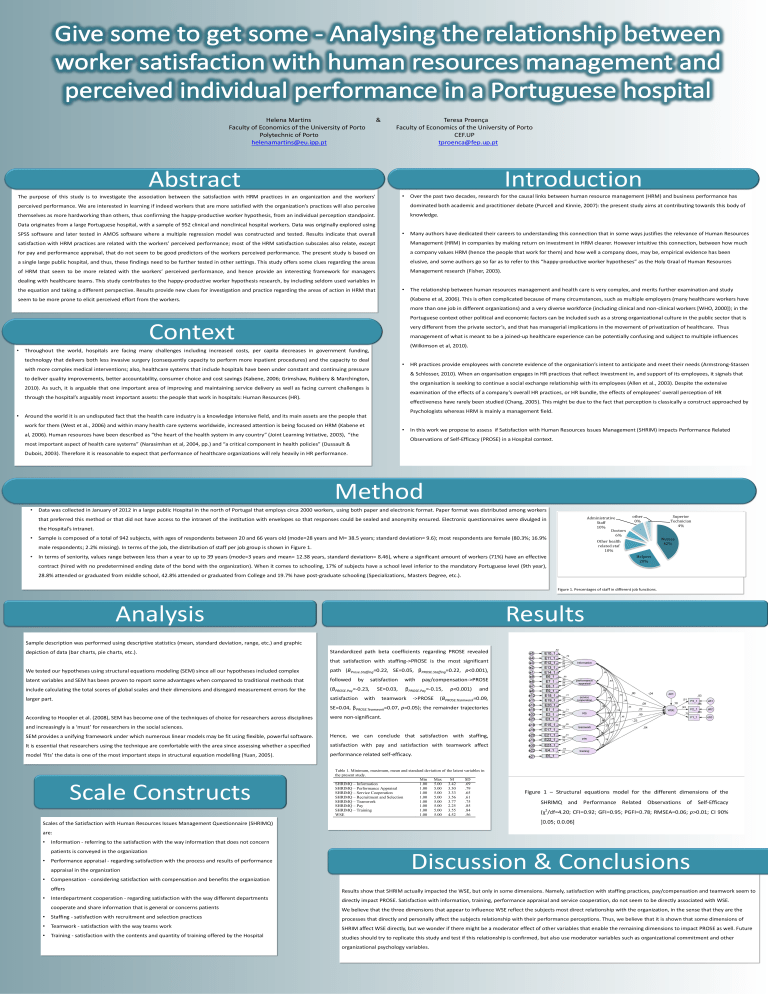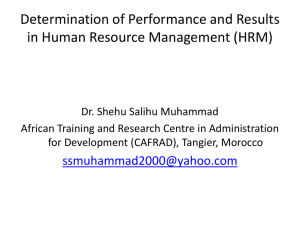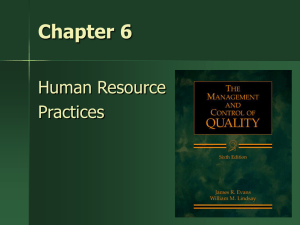B PROSE.Pay

Helena Martins & Teresa Proença
Faculty of Economics of the University of Porto Faculty of Economics of the University of Porto
Polytechnic of Porto CEF.UP
helenamartins@eu.ipp.pt
tproenca@fep.up.pt
Abstract
The purpose of this study is to investigate the association between the satisfaction with HRM practices in an organization and the workers' perceived performance. We are interested in learning if indeed workers that are more satisfied with the organization’s practices will also perceive themselves as more hardworking than others, thus confirming the happy-productive worker hypothesis, from an individual perception standpoint.
Data originates from a large Portuguese hospital, with a sample of 952 clinical and nonclinical hospital workers. Data was originally explored using
SPSS software and later tested in AMOS software where a multiple regression model was constructed and tested. Results indicate that overall satisfaction with HRM practices are related with the workers’ perceived performance; most of the HRM satisfaction subscales also relate, except for pay and performance appraisal, that do not seem to be good predictors of the workers perceived performance. The present study is based on a single large public hospital, and thus, these findings need to be further tested in other settings. This study offers some clues regarding the areas of HRM that seem to be more related with the workers’ perceived performance, and hence provide an interesting framework for managers dealing with healthcare teams. This study contributes to the happy-productive worker hypothesis research, by including seldom used variables in the equation and taking a different perspective. Results provide new clues for investigation and practice regarding the areas of action in HRM that seem to be more prone to elicit perceived effort from the workers.
Context
• Throughout the world, hospitals are facing many challenges including increased costs, per capita decreases in government funding, technology that delivers both less invasive surgery (consequently capacity to perform more inpatient procedures) and the capacity to deal with more complex medical interventions; also, healthcare systems that include hospitals have been under constant and continuing pressure to deliver quality improvements, better accountability, consumer choice and cost savings (Kabene, 2006; Grimshaw, Rubbery & Marchington,
2010). As such, it is arguable that one important area of improving and maintaining service delivery as well as facing current challenges is through the hospital’s arguably most important assets: the people that work in hospitals: Human Resources (HR).
• Around the world it is an undisputed fact that the health care industry is a knowledge intensive field, and its main assets are the people that work for them (West et al., 2006) and within many health care systems worldwide, increased attention is being focused on HRM (Kabene et al, 2006). Human resources have been described as “the heart of the health system in any country” (Joint Learning Initiative, 2003), “the most important aspect of health care systems” (Narasimhan et al, 2004, pp.) and “a critical component in health policies” (Dussault &
Dubois, 2003). Therefore it is reasonable to expect that performance of healthcare organizations will rely heavily in HR performance.
Introduction
• Over the past two decades, research for the causal links between human resource management (HRM) and business performance has dominated both academic and practitioner debate (Purcell and Kinnie, 2007): the present study aims at contributing towards this body of knowledge.
• Many authors have dedicated their careers to understanding this connection that in some ways justifies the relevance of Human Resources
Management (HRM) in companies by making return on investment in HRM clearer. However intuitive this connection, between how much a company values HRM (hence the people that work for them) and how well a company does, may be, empirical evidence has been elusive, and some authors go so far as to refer to this “happy-productive worker hypotheses” as the Holy Graal of Human Resources
Management research (Fisher, 2003).
• The relationship between human resources management and health care is very complex, and merits further examination and study
(Kabene et al, 2006). This is often complicated because of many circumstances, such as multiple employers (many healthcare workers have more than one job in different organizations) and a very diverse workforce (including clinical and non-clinical workers [WHO, 2000]); in the
Portuguese context other political and economic factors can be included such as a strong organizational culture in the public sector that is very different from the private sector’s, and that has managerial implications in the movement of privatization of healthcare. Thus management of what is meant to be a joined-up healthcare experience can be potentially confusing and subject to multiple influences
(Wilkimson et al, 2010).
• HR practices provide employees with concrete evidence of the organisation’s intent to anticipate and meet their needs (Armstrong-Stassen
& Schlosser, 2010). When an organisation engages in HR practices that reflect investment in, and support of its employees, it signals that the organisation is seeking to continue a social exchange relationship with its employees (Allen et al., 2003). Despite the extensive examination of the effects of a company’s overall HR practices, or HR bundle, the effects of employees’ overall perception of HR effectiveness have rarely been studied (Chang, 2005). This might be due to the fact that perception is classically a construct approached by
Psychologists whereas HRM is mainly a management field.
• In this work we propose to assess if Satisfaction with Human Resources Issues Management (SHRIM) impacts Performance Related
Observations of Self-Efficacy (PROSE) in a Hospital context.
Method
• Data was collected in January of 2012 in a large public Hospital in the north of Portugal that employs circa 2000 workers, using both paper and electronic format. Paper format was distributed among workers that preferred this method or that did not have access to the intranet of the institution with envelopes so that responses could be sealed and anonymity ensured. Electronic questionnaires were divulged in the Hospital’s intranet.
• Sample is composed of a total of 942 subjects, with ages of respondents between 20 and 66 years old (mode=28 years and M= 38.5 years; standard deviation= 9.6); most respondents are female (80.3%; 16.9% male respondents; 2.2% missing). In terms of the job, the distribution of staff per job group is shown in Figure 1.
• In terms of seniority, values range between less than a year to up to 39 years (mode=3 years and mean= 12.38 years, standard deviation= 8.46), where a significant amount of workers (71%) have an effective contract (hired with no predetermined ending date of the bond with the organization). When it comes to schooling, 17% of subjects have a school level inferior to the mandatory Portuguese level (9th year),
28.8% attended or graduated from middle school, 42.8% attended or graduated from College and 19.7% have post-graduate schooling (Specializations, Masters Degree, etc.).
Analysis
Administrative
Staff
10%
Doctors
6%
Other health related staf
10% other
0%
Helpers
28%
Nurses
42%
Superior
Technician
4%
Figure 1. Percentages of staff in different job functions.
Results
Sample description was performed using descriptive statistics (mean, standard deviation, range, etc.) and graphic depiction of data (bar charts, pie charts, etc.).
We tested our hypotheses using structural equations modeling (SEM) since all our hypotheses included complex latent variables and SEM has been proven to report some advantages when compared to traditional methods that include calculating the total scores of global scales and their dimensions and disregard measurement errors for the larger part.
According to Hoopler et al. (2008), SEM has become one of the techniques of choice for researchers across disciplines and increasingly is a ‘must’ for researchers in the social sciences.
SEM provides a unifying framework under which numerous linear models may be fit using flexible, powerful software.
It is essential that researchers using the technique are comfortable with the area since assessing whether a specified model ‘fits’ the data is one of the most important steps in structural equation modelling (Yuan, 2005).
Standardized path beta coefficients regarding PROSE revealed that satisfaction with staffing->PROSE is the most significant path (B
Prose.Staffing
=0.22, SE=0.05, β
PROSE.Staffing
=0.22, p<0.001), followed by satisfaction with pay/compensation->PROSE
(B
PROSE.Pay
=-0.23, SE=0.03, β
PROSE.Pay
=-0.15, p<0.001) and satisfaction with teamwork ->PROSE (B
PROSE.Teamwork
=0.09,
SE=0.04, β
PROSE.Teamwork
=0.07, p=0.05); the remainder trajectories were non-significant.
Scale Constructs
Scales of the Satisfaction with Human Resources Issues Management Questionnaire (SHRIMQ) are:
• Information - referring to the satisfaction with the way information that does not concern patients is conveyed in the organization
• Performance appraisal - regarding satisfaction with the process and results of performance appraisal in the organization
• Compensation - considering satisfaction with compensation and benefits the organization offers
• Interdepartment cooperation - regarding satisfaction with the way different departments cooperate and share information that is general or concerns patients
• Staffing - satisfaction with recruitment and selection practices
• Teamwork - satisfaction with the way teams work
• Training - satisfaction with the contents and quantity of training offered by the Hospital
Hence, we can conclude that satisfaction with staffing, satisfaction with pay and satisfaction with teamwork affect performance related self-efficacy.
Table 1. Minimum, maximum, mean and standard deviation of the latent variables in the present study.
Min Max M SD
SHRIMQ – Information
SHRIMQ – Performance Appraisal
SHRIMQ – Service Cooperation
SHRIMQ – Recruitment and Selection
SHRIMQ – Teamwork
SHRIMQ – Pay
SHRIMQ – Training
WSE
1.00
1.00
1.00
1.00
5.00
5.00
5.00
5.00
3.42
3.30
3.33
3.56
.69
.79
.65
.61
1.00 5.00 3.77 .75
1.00 5.00 2.25 .85
1.00 5.00 3.55 .84
1.00 5.00 4.52 .56
Discussion & Conclusions
Results show that SHRIM actually impacted the WSE, but only in some dimensions. Namely, satisfaction with staffing practices, pay/compensation and teamwork seem to directly impact PROSE. Satisfaction with information, training, performance appraisal and service cooperation, do not seem to be directly associated with WSE.
We believe that the three dimensions that appear to influence WSE reflect the subjects most direct relationship with the organization, in the sense that they are the processes that directly and personally affect the subjects relationship with their performance perceptions. Thus, we believe that it is shown that some dimensions of
SHRIM affect WSE directly, but we wonder if there might be a moderator effect of other variables that enable the remaining dimensions to impact PROSE as well. Future studies should try to replicate this study and test if this relationship is confirmed, but also use moderator variables such as organizational commitment and other organizational psychology variables.






